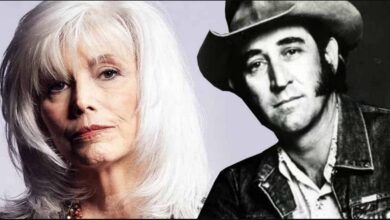Marty Robbins’ Cherished Version Of “I Walk Alone”
Marty Robbins, born on September 26, 1925, in Glendale, Arizona, was a prolific American singer, songwriter, and musician who became one of the most influential figures in country music. His career spanned several decades, during which he produced numerous hits that showcased his remarkable versatility and creativity. Robbins was not just a country artist; he also dabbled in pop, rockabilly, and Western styles, which broadened his appeal and solidified his place in the annals of music history.
Marty’s rise to fame began in the late 1940s and early 1950s, a time when country music was becoming increasingly popular across the United States. His early work often focused on the traditional storytelling aspect of country music, with songs that narrated tales of love, loss, and the American experience. His unique ability to weave narrative and emotion into his music distinguished him from his contemporaries. With hits like “El Paso,” which won a Grammy Award in 1961, Robbins proved to be a master storyteller, captivating audiences with vivid imagery and compelling melodies.
“I Walk Alone,” released in 1968, represents a mature phase of Robbins’ artistry. The song reflects a poignant sense of solitude, a theme that resonates with many, particularly those who have experienced the emotional toll of frequent travel. The lyrics are evocative, painting a picture of a lonesome traveler balancing the joys and sorrows of his profession. Robbins’ rich baritone voice enhances the depth of the narrative, allowing listeners to feel the weight of his experiences.
In addition to his vocal talents, Robbins was a skilled songwriter. He wrote many of the songs he performed, allowing him to infuse his personal experiences and emotions into his work. This authenticity is a significant part of what makes “I Walk Alone” and other Robbins songs resonate so deeply with listeners. The blend of personal narrative and universal themes of love and isolation is a hallmark of his songwriting.
Another compelling aspect of Robbins’ work is his innovative approach to music production. He often incorporated orchestral elements into his recordings, making his sound more sophisticated and appealing to a wider audience. The arrangement of “I Walk Alone,” with its carefully layered instrumentation, showcases this talent, creating a sonic landscape that complements the emotional weight of the lyrics.
Robbins’ influence extended beyond his music. He was also a noted figure in film, having appeared in various Western films and television shows. His connection to the Western genre not only enriched his musical themes but also endeared him to fans of cowboy culture and stories. This crossover appeal further cemented his legacy as a true American icon.
Throughout his career, Robbins received numerous accolades and honors that recognized his contributions to music. He was inducted into the Country Music Hall of Fame in 1982, a testament to his lasting impact on the genre. His songs continue to be covered and celebrated by new generations of artists, ensuring that his music remains alive in the cultural consciousness.
While Robbins passed away on December 8, 1982, his music lives on. Tracks like “I Walk Alone” are frequently revisited, serving not only as a reminder of Robbins’ talent but also as a reflection of the emotions that many face in their lives. The ability to evoke such feelings in listeners is a powerful legacy and speaks to the truth that music can heal and connect us all.
Overall, Marty Robbins is remembered not just for his hits but for his profound influence on country music and its storytelling traditions. His work continues to inspire artists today, and the emotional depth found in songs like “I Walk Alone” serves as a bridge between generations, showcasing the timeless nature of heartfelt music. Through his enduring songs, Robbins remains a cherished figure whose artistry resonates with audiences, providing comfort and connection far beyond his time.





